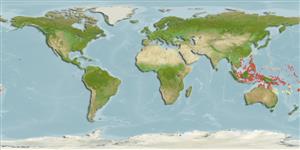Environment: milieu / climate zone / depth range / distribution range
Ecology
Marine; brackish; demersal; depth range 0 - 14 m (Ref. 127519). Tropical
Western Central Pacific: Malaysia, Indonesia, Fiji.
Size / Weight / Age
Maturity: Lm ? range ? - ? cm
Max length : 6.3 cm SL male/unsexed; (Ref. 3178)
Dorsal spines (total): 6 - 7; Dorsal soft rays (total): 7 - 8; Anal spines: 1; Anal soft rays: 7. Characterized by greyish brown body color; presence of five brown saddles on back from nape to caudal peduncle; row of brown blotches along middle of side; dorsal and caudal fins with brown spotting; rounded caudal fin; longitudinal scale series 30; predorsal scales 10; ctenoid scales posteriorly, becoming cycloid anteriorly; head without scales except nape region; depth of body 4.0-5.0 in SL (Ref. 90102).
Inhabits silty reefs in 0-5 m (Ref. 90102).
Life cycle and mating behavior
Maturities | Reproduction | Spawnings | Egg(s) | Fecundities | Larvae
Weber, M. and L.F. De Beaufort, 1953. The fishes of the Indo-Australian archipelago. X. Gobioidea. A.J. Reprints Agency, New Delhi. 423 p. (Ref. 3178)
IUCN Red List Status (Ref. 130435)
Threat to humans
Harmless
Human uses
Tools
Special reports
Download XML
Internet sources
Estimates based on models
Preferred temperature (Ref.
123201): 27.4 - 29.3, mean 28.8 °C (based on 1504 cells).
Phylogenetic diversity index (Ref.
82804): PD
50 = 0.5625 [Uniqueness, from 0.5 = low to 2.0 = high].
Bayesian length-weight: a=0.00708 (0.00333 - 0.01504), b=3.09 (2.92 - 3.26), in cm total length, based on LWR estimates for this (Sub)family-body shape (Ref.
93245).
Trophic level (Ref.
69278): 3.3 ±0.3 se; based on size and trophs of closest relatives
Resilience (Ref.
120179): High, minimum population doubling time less than 15 months (Preliminary K or Fecundity.).
Fishing Vulnerability (Ref.
59153): Low vulnerability (10 of 100).
